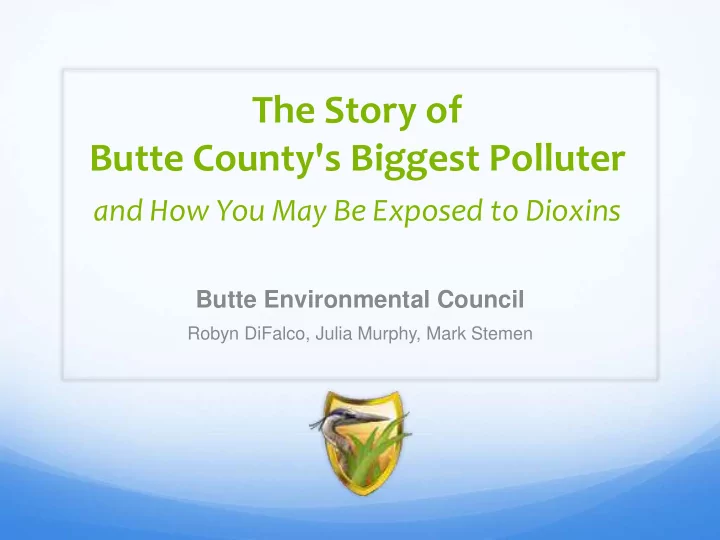

The Story of Butte County's Biggest Polluter and How You May Be Exposed to Dioxins Butte Environmental Council Robyn DiFalco, Julia Murphy, Mark Stemen
Butte Environmental Council Educating and Advocating for the land, air, and water in Butte County and beyond A voice for the environment since 1975 Our work depends on volunteers, member donations, grants, and fundraising Butte Environmental Council
The Story of POPI Pacific Oroville Power Industries (POPI) Located in south Oroville highway 7o Industrial Park Biomass energy facility First permitted in 1983 Covanta- owned since ‘97 Butte Environmental Council
The Pacific Oroville Power Industries (POPI) plant consumes 28 tons of fuel per hour Butte Environmental Council
Up to 30% urban wood waste • Construction & demolition debris Recycling credits Renewable energy credits Butte Environmental Council
Bituminous coal Butte Environmental Council
So what happens to the waste? Covanta pays farmers $17/ton to take the waste ash as fertilizer Butte Environmental Council
Waste ash: Hicks Ln, north Chico 19,000 tons 20 ft high Wider & longer than a football field Butte Environmental Council
Digging for Dioxins District Attorney’s office investigating waste ash Chromium, Arsenic, Copper, Aluminum and Lead found in DA’s tests Butte Environmental Council
What’s the Current Status? September 2012 – Ash removal from Hicks Ln BEC tests show post-cleanup dioxin levels are higher than background samples & that dioxin migrates as runoff December 2012 – POPI plant ceases operations “for economic reasons” Covanta retains permits, PG&E seeks revision of terms Butte Environmental Council
Wait… Can they do that? Facility is self-monitored Full evaluation of exhaust stacks last in 1988 Reports to Butte County Air Quality Management District POPI pays $12,000/year in permit fees to BCAQMD Butte Environmental Council
What is Dioxin? Over 250 variations, or “congeners” Agent Orange Love Canal – Lois Gibbs the Center for Health & Environmental Justice Toxic & Controversial Butte Environmental Council
Why is Dioxin a Big Deal? Incinerator, Chemical Manufacturing industry by-product Persistent in the environment Persistent in animals and humans Butte Environmental Council
Butte Environmental Council
Koppers Superfund Site Grant from The California Wellness Foundation Dioxin Testing process Agency Relations Butte Environmental Council
According to the Environmental Health Investigations Branch: “ The US Food and Drug Administration (has also) considered commercial eggs adulterated at 1 ppt ITEQ.” (Environ. Sci. Technol. 2000 , 34, 1143-1149) Butte Environmental Council
POPI / Covanta Deputy DA wanted to know what we knew We began investigating, tested waste ash OH, WHAAAT!!?? On Orchards and Farms??! Butte Environmental Council
Biomass is “green” energy Butte Environmental Council
Wood is “natural” Butte Environmental Council
But what about this? Butte Environmental Council
POPI ash tests revealed: Lead (most dominant due to old paint) Copper Arsenic Chromium Butte Environmental Council
How about CO2 emissions? Butte Environmental Council
Burning wood in an incinerator to generate electricity produces more CO2 per unit of energy than a coal-fired power plant! Carbon Dioxide Emissions by Energy Source (lbs/MWh) 3500 3000 2500 2000 1500 1000 500 0 Incineration Coal-Fired Oil-fired Natural Gas Butte Environmental Council
Saleable, my ash Butte Environmental Council
California’s Renewable Energy Requirements Established in 2002 by Senate Bill 1078, the State of California Renewable Portfolio Standard (RPS) is one of the most ambitious renewable energy standards in the country, requiring electricity providers to increase the portion of energy from renewable sources to 20% by 2010 and to 33% by 2020. PG&E pays POPI a premium price for its power, and includes it as part of its renewable portfolio. The agreement also requires POPI to run at full-capacity regardless of local fuel availability Butte Environmental Council
POPI is dirty energy and should not be subsidized by PG&E Anything that creates pollution in the course of producing electricity shouldn't be considered clean, green or renewable. Butte Environmental Council
Or by anybody, anywhere else! Butte Environmental Council
And question “green” technology Butte Environmental Council
What Next? Grant funding from Patagonia & Clif Bar Measure human exposure & health impacts Meet with elected officials and local regulators Watch for reoperation of the POPI facility Butte Environmental Council
Questions? Contact… Butte Environmental Council Robyn DiFalco, Julia Murphy, Mark Stemen www.becnet.org www.becnet.org/dioxin-butte-county 530-891-6424 staff@becnet.org Butte Environmental Council
Recommend
More recommend